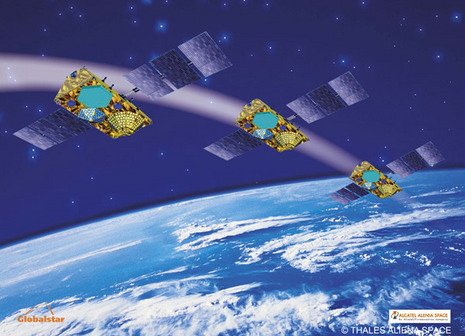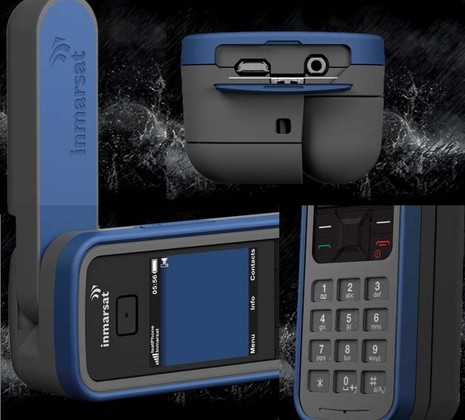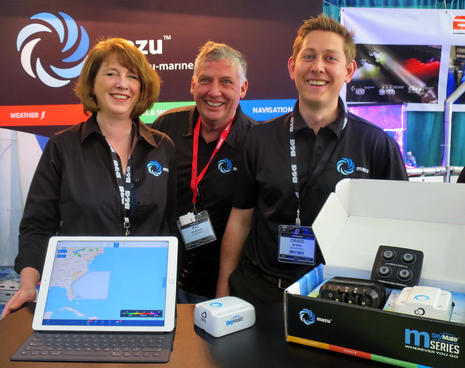Inmarsat, Iridium, & Globalstar…the horse race
Competitive heat is really building in the portable global sat phone/messenger sector, and once it gets sorted, it’s got to be good news for those of us who venture beyond cellular networks. Last week Iridium announced that its smaller, cheaper 9602 SBD modem is ready ahead of schedule for some 90 “integration partners,” and a few weeks before that Inmarsat detailed its IsatPhone Pro (due in June), including its game changing pricing. And while I discussed both of these developments here in January, it’s Globalstar that may be the long term dark horse in this race…
Last Friday Globalstar announced its 2nd generation satellite timetable, and two aspects of the release jump out at me. Besides restoring its once excellent voice quality, Globalstar is promising that this new constellation will eventually provide “data speeds of up to 256
kbps in a flexible Internet protocol multimedia subsystem (IMS)
configuration” expected to provide services like “push-to-talk and multicasting, advanced messaging capabilities
such as multimedia messaging or MMS, mobile video, geo-location
services, multi-band and multi-mode handsets, and data devices with GPS
integration.” Wow.
Now we have heard fabulous forecasts for future satellite services before, which didn’t work out, but also mentioned in the release is the “$738 million financing to
fully fund manufacture and launch of 24 new second-generation satellites” secured last year. This is not exactly fresh news, and deals like this have collapsed before, but a sharp someone in the marine industry recently told me that the French government is behind this deal (because Thales Alenia Space is building all those new birds) and it’s probably going to happen no matter what. Then again that Globalstar timetable only goes to a September ready-to-launch date, and this sat industry article seems to suggest that it needs to maintain its phone and Spot Messenger services to make it through the long haul. Which may explain in part why Iridium and Inmarsat seem so intent on chipping away at those businesses…
 Yes indeed, much to my surprise, it’s now official that Inmarsat’s IsatPhone Pro will have a retail price of $699 — and will likely sell for $500-$600 — with “retail airtime rates of around US$1 per minute.” There don’t seem to be images of a real phone yet (hence the collage at top), but Inmarsat has put up a lot of technical detail here, and this looks like a heck of a sat phone. But don’t miss the Q & A PDF at the bottom of that page either, as it notes that the phone’s 2.4 kbps data service won’t be available until early 2011. Still text messaging and text-to-email will be available right off, along with modern cell phone features like Outlook contact synchronization and GPS integration.
Yes indeed, much to my surprise, it’s now official that Inmarsat’s IsatPhone Pro will have a retail price of $699 — and will likely sell for $500-$600 — with “retail airtime rates of around US$1 per minute.” There don’t seem to be images of a real phone yet (hence the collage at top), but Inmarsat has put up a lot of technical detail here, and this looks like a heck of a sat phone. But don’t miss the Q & A PDF at the bottom of that page either, as it notes that the phone’s 2.4 kbps data service won’t be available until early 2011. Still text messaging and text-to-email will be available right off, along with modern cell phone features like Outlook contact synchronization and GPS integration.
In fact, a sat phone specialist at the Miami show theorized that a relatively low cost IsatPhone with decent small data abilities might do a lot of what seems possible with Iridium’s Small Burst Data technology. It’s worth noting, for instance, that Inmarsat’s recently introduced FleetBroadband 505 Emergency Calling service seems like it could work fine with the IsatPhone. But don’t forget that “more than 90 Iridium partners have tested the 9602 for
integration into new products” and that planned applications
include “telemetry from unattended sensors, fleet management, …tracking soldiers and military
vehicles, and personal two-way navigation and mapping.” Isn’t this an interesting horse race?














We have an investment in an SSB/Pactor modem set up (it’s getting delivered this month, in fact), because in two years we’ll be off for a few years voyaging and will need GRIB files and (limited) SailMail in order to educate our son and assure our families we haven’t sunk.
But I must say, if the price of satphones is approaching the $500 mark, they are very close to that “sweet spot” whereby purchasing one becomes a no-brainer, just like a PLB or a Spinlock PFD currently is. The utility of having one aboard (maybe next to the ditch bag) justifies the cost. I assume that if you use it rarely, there’s a low “account fee”, but there’s a lot of reasons to make short voice calls or brief Internet forays using it in emergencies or when the SSB conditions aren’t ideal and cadging a wireless connection isn’t possible.
Thanks for the update.
The cost of the hardware is now irrelevant. It’s all about the cost of the service.
Kodak used to give away cameras to create a market for film, and HP sets low prices on its printers and makes its money on the ink.
It may still be a good deal, but you have to look at the real costs.
Well, the rationale is why buy suspenders when you’ve got a belt? Those suspenders could outlast several belts, because they are rarely supporting pants.
A satphone that is five bills to own and is used ten minutes a month, when SSB propagation is bad, you really need a GRIB file or for a five-minute call to relatives is peanuts.
If you started using it to text idiots like most cellphones, you’d merit the vast charges.
But if it’s a backup to other devices, and only really used in emergencies and/or for really brief calls, I can see it as an attractive proposal.
But then I’m the sort of guy who’s had a 200 minute a month cell phone plan (the cheapest) for 15 years…that I never exceed.
We rarely use our Skipper 150. However when we need it, it works as promised. Once we start our journey south to rural North Carolina our new home where WiFi and Cellular data is spotty at best. I am happy to know we can contact anyone needed and get critical time sensative business e-mail when needed. The usage costs for all VSAT phones are quite high for the data rate but it sure beats no connection. I wish someone would strike a deal with Hughes.Net and make a unit like the FB150 for US Coastal cruisers. Their data plans are inexpensive compared to BGAN, Fleet or INMARSAT. GlobalStar will have to prove themselves to me before I would ever deal with them again. I really felt burnt after I purchased a unit, got nothing but excusses before they admitted problems. I ended up giving the unit away. They tried to keep me by offering a $10.00 a month plan but when I need a connection I can’t or don’t want to wait 15 to 20 minutes only to have the call or data connection drop within minutes.
Bill
I’ve used BGAN and loved it – broadband, at sea, on a trip from New England to the BVI, with no problems. The $8 per megabyte cost was prohibitive, however, as was the cost of the unit retail. This time, coming back from the BVI, I was planning on relying on my Iridium sat phone for data – which I bought from AllRoadsSat.com a couple of years ago. It had operated pretty reliably from Cape Town to Newport, RI last year; it was slow, but it worked. But this time – mid-May – I could not transfer data. I could start the call, and had plenty of “bars,” but the data simply didn’t flow. Many calls to tech support (free, thankfully – you have to call 6868) convinced me that Iridium was “upgrading” their system and the data service was effectively DOWN while that was happening. Very disappointing, for someone who continues to work while crossing oceans. The downside to using the sat phone for data is that you pay by the minute, and with the connection times so slow, the minutes can really add up. In the long run, I came to the conclusion that BGAN data costs were cheaper than sat phone data costs. You wouldn’t want to surf the web, but for business email and necessary website visits, it was hard to beat.
Unless I am mistaken, BGAN is the terrestrial equivalent of Mini-VSAT. I’ve always been curious about what would happen if you tried using BGAN equipment like the Hughes 9250 on a boat (they’re made for truck tops and such). Were you actually using BGAN hardware? If so additional comments on the experience would be much appreciated.
Thanks!
/afb
Interesting! Today we learn that the Iridium NEXT satellite system — 81 birds altogether, 2.9 billion dollars worth — will be built by the same company that’s building the new Globalstar system, with financing guaranteed by the same “Compagnie Francaise d’Assurance pour le Commerce Exterieur.”
http://news.bbc.co.uk/2/hi/science_and_environment/10212836.stm
Yesterday Iridium announced “new features” for its 9555 sat phone:
http://www.itnewsonline.com/news/Iridium-Introduces-New-Features-for-Its-Latest-Global-Satellite-Phone/19110/7/3
Sounds like new firmware that improves (fixes?) interfacing with Windows XP, Vista, & 7 PCs plus Macs. SMS messaging limits also go from 160 characters to 1,000. Nothing like a like competition!
I think personally the competition between Inmarsat and Iridium will start soon due to the apparition of new IsatPhone Pro, and the greatest price and capabilities of the new terminal. Probably Iridium will be forced to drop down their prices soon to maintain their customers using the 9505,9595a and the latest satphone 9555.
I used a new internet retail store to pre-order a new device of Inmarsat at really interesting price (630$/499€) in http://www.prepaidsatphone.com. I’m curious to test deeply this new device within coastal waters, how is going on.
Keep you updated.
Ed.
For any investors out their that may know about Iridium, what is going on with their financing? I have been hearing it is not a done deal and that even if it goes through, they most likely won’t be able to meet the debt payments based on current revenue forecasts. Just wondering if I should jump ship. Any info is appreciated, thanks.
Jump ship as an employee or customer?
I just looked at the Balance Sheet as of 3/31/10 and it looks very nice with a current ratio of about 2.5. They would have to have fallen awfully hard since 3/31 to have a problem paying their bills.
Who started this nasty rumor?
Thank you Russ. As an investor, not employee or customer.
Does that balance sheet take into account the $1.8 billion debt they would be taking on if they get the COFACE financing? I was seeing that if they get the financing they won’t be able to pay it off, and if they don’t get it they’ll never be able to upgrade the network.
Jack: No, balance sheets are just a snapshot of a point in time.
However, the arrangement with Thales, backed by Coface, looks like an outstandingly good deal for Iridium. They have a fixed price contract with Thales for the next generation of satellites, and a 95% loan guarantee from Coface. This will enable them to borrow the $1.8B at a very low spread over the already historically low interest rates. It’s essentially analogous to a Freddie Mac home loan, backed by the US government. Lenders demand a very low spread over treasury bills, and this debt should have a very low spread over French soverign debt.
I don’t know if their stock is going to go up or down, but I think the company is going to be around for quite awhile.